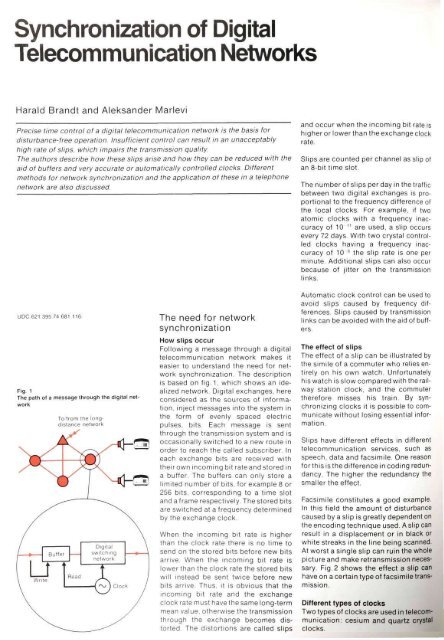TELE-X - a Satellite System for TV and Data Communication ...
TELE-X - a Satellite System for TV and Data Communication ...
TELE-X - a Satellite System for TV and Data Communication ...
Create successful ePaper yourself
Turn your PDF publications into a flip-book with our unique Google optimized e-Paper software.
Synchronization of Digital<br />
Telecommunication Networks<br />
Harald Br<strong>and</strong>t <strong>and</strong> Aleks<strong>and</strong>er Marlevi<br />
Precise time control of a digital telecommunication network is the basis <strong>for</strong><br />
disturbance-free operation. Insufficient control can result in an unacceptable<br />
high rate of slips, which impairs the transmission quality.<br />
The authors describe how these slips arise <strong>and</strong> how they can be reduced with the<br />
aid of buffers <strong>and</strong> very accurate or automatically controlled clocks. Different<br />
methods <strong>for</strong> network synchronization <strong>and</strong> the application of these in a telephone<br />
network are also discussed.<br />
<strong>and</strong> occur when the incoming bit rate is<br />
higher or lower than the exchange clock<br />
rate.<br />
Slips are counted per channel as slip of<br />
an 8-bit time slot.<br />
The number of slips per day in the traffic<br />
between two digital exchanges is proportional<br />
to the frequency difference of<br />
the local clocks. For example, if two<br />
atomic clocks with a frequency inaccuracy<br />
of 10 11 are used, a slip occurs<br />
every 72 days With two crystal controlled<br />
clocks having a frequency inaccuracy<br />
of 10 6 the slip rate is one per<br />
minute. Additional slips can also occur<br />
because of jitter on the transmission<br />
links.<br />
UDC 621.395.74:681.116<br />
Fig. 1<br />
The path of a message through the digital network<br />
To/from the longdistance<br />
network<br />
The need <strong>for</strong> network<br />
synchronization<br />
How slips occur<br />
Following a message through a digital<br />
telecommunication network makes it<br />
easier to underst<strong>and</strong> the need <strong>for</strong> network<br />
synchronization. The description<br />
is based on fig. 1, which shows an idealized<br />
network. Digital exchanges, here<br />
considered as the sources of in<strong>for</strong>mation,<br />
inject messages into the system in<br />
the <strong>for</strong>m of evenly spaced electric<br />
pulses, bits. Each message is sent<br />
through the transmission system <strong>and</strong> is<br />
occasionally switched to a new route in<br />
order to reach the called subscriber. In<br />
each exchange bits are received with<br />
their own incoming bit rate <strong>and</strong> stored in<br />
a buffer. The buffers can only store a<br />
limited number of bits, <strong>for</strong> example 8 or<br />
256 bits, corresponding to a time slot<br />
<strong>and</strong> a frame respectively. The stored bits<br />
are switched at a frequency determined<br />
by the exchange clock.<br />
When the incoming bit rate is higher<br />
than the clock rate there is no time to<br />
send on the stored bits be<strong>for</strong>e new bits<br />
arrive. When the incoming bit rate is<br />
lower than the clock rate the stored bits<br />
will instead be sent twice be<strong>for</strong>e new<br />
bits arrive. Thus, it is obvious that the<br />
incoming bit rate <strong>and</strong> the exchange<br />
clock rate must havethesame long-term<br />
mean value, otherwise the transmission<br />
through the exchange becomes distorted.<br />
The distortions are called slips<br />
Automatic clock control can be used to<br />
avoid slips caused by frequency differences.<br />
Slips caused by transmission<br />
links can be avoided with the aid of buffers.<br />
The effect of slips<br />
The effect of a slip can be illustrated by<br />
the simile of a commuter who relies entirely<br />
on his own watch. Un<strong>for</strong>tunately<br />
his watch is slow compared with the railway<br />
station clock, <strong>and</strong> the commuter<br />
there<strong>for</strong>e misses his train. By synchronizing<br />
clocks it is possible to communicate<br />
without losing essential in<strong>for</strong>mation.<br />
Slips have different effects in different<br />
telecommunication services, such as<br />
speech, data <strong>and</strong> facsimile. One reason<br />
<strong>for</strong>this isthedifference in coding redundancy.<br />
The higher the redundancy the<br />
smaller the effect.<br />
Facsimile constitutes a good example.<br />
In this field the amount of disturbance<br />
caused by a slip is greatly dependent on<br />
the encoding technique used. A slip can<br />
result in a displacement or in black or<br />
white streaks in the line being scanned.<br />
At worst a single slip can ruin the whole<br />
picture <strong>and</strong> make retransmission necessary.<br />
Fig. 2 shows the effect a slip can<br />
have on a certain type of facsimile transmission.<br />
Different types of clocks<br />
Two types of clocks are used in telecommunication:<br />
cesium <strong>and</strong> quartz crystal<br />
clocks.
















